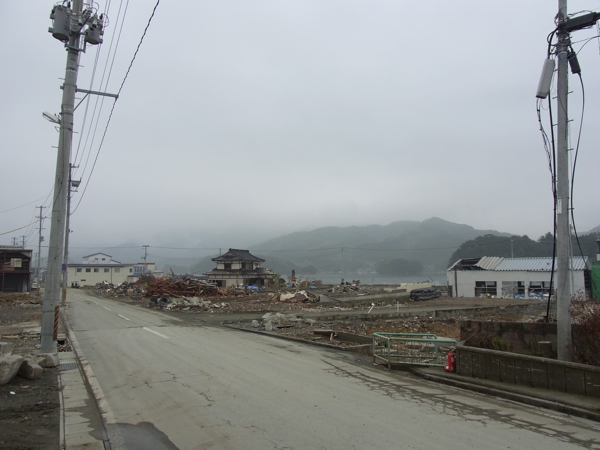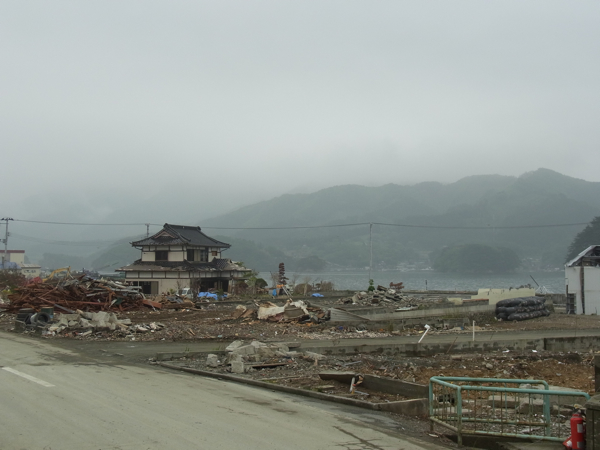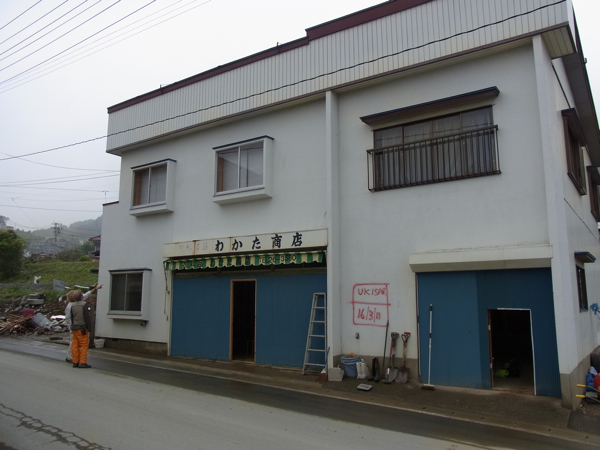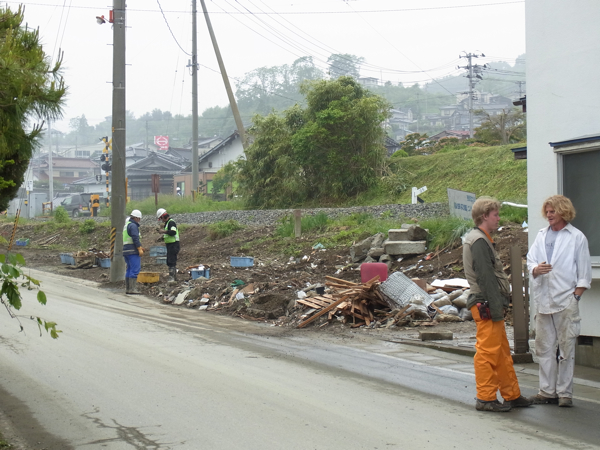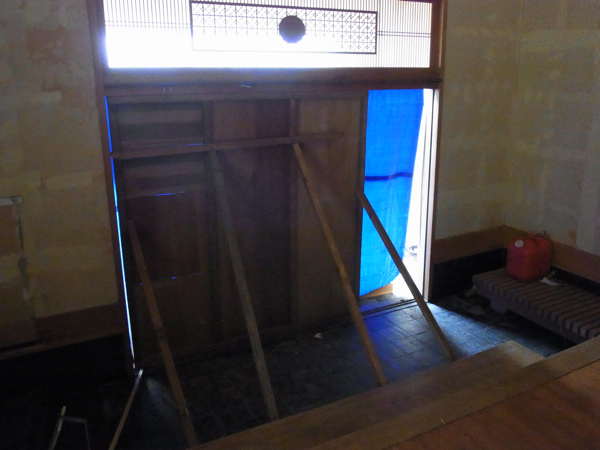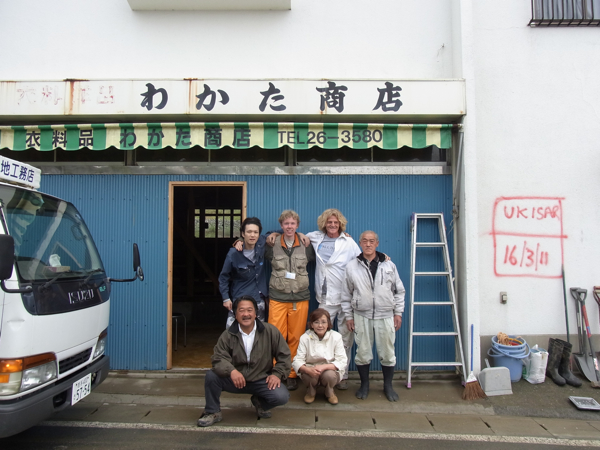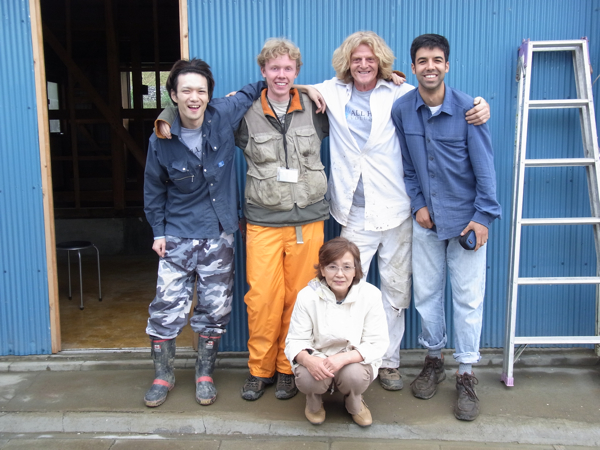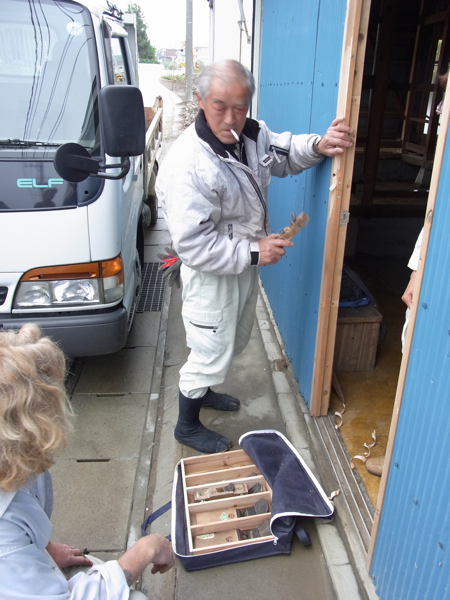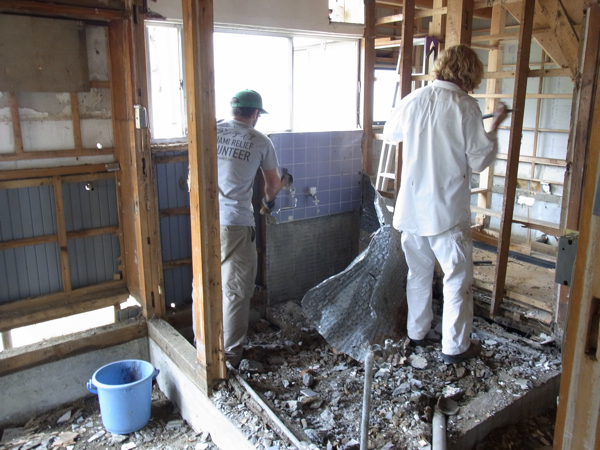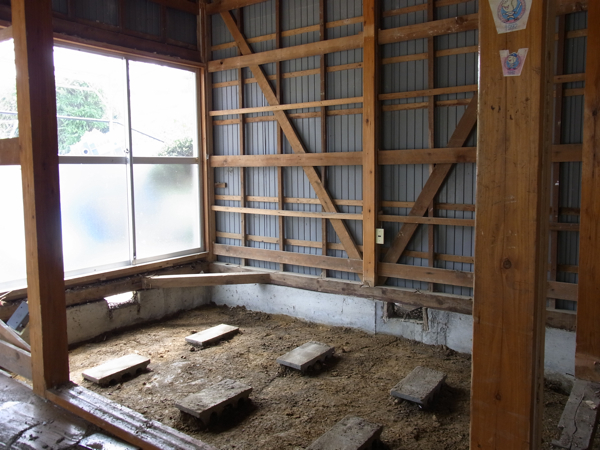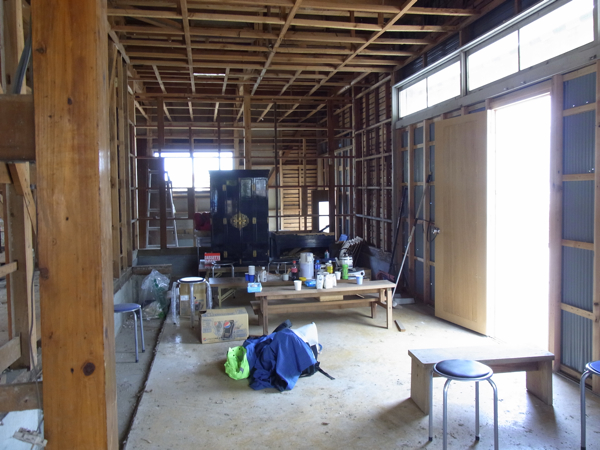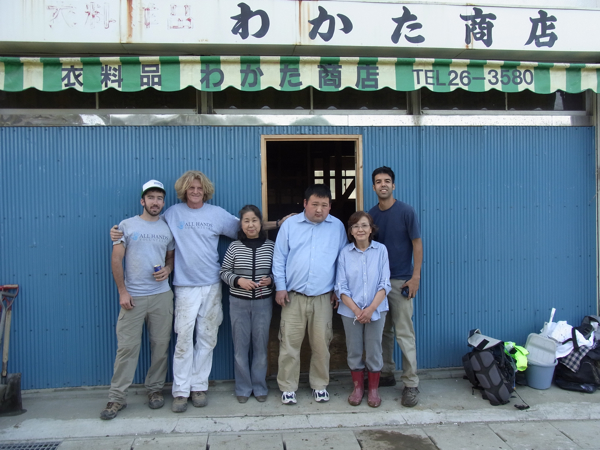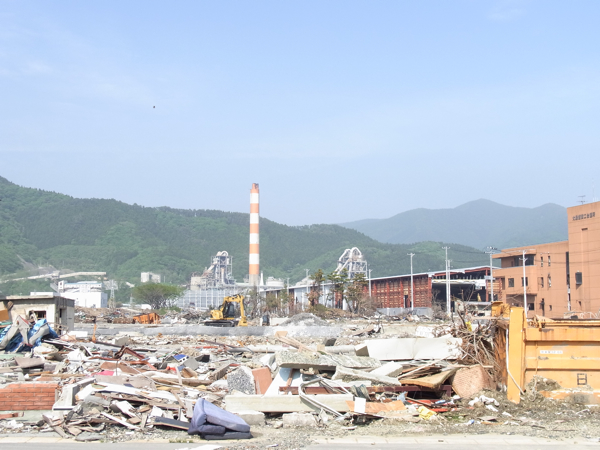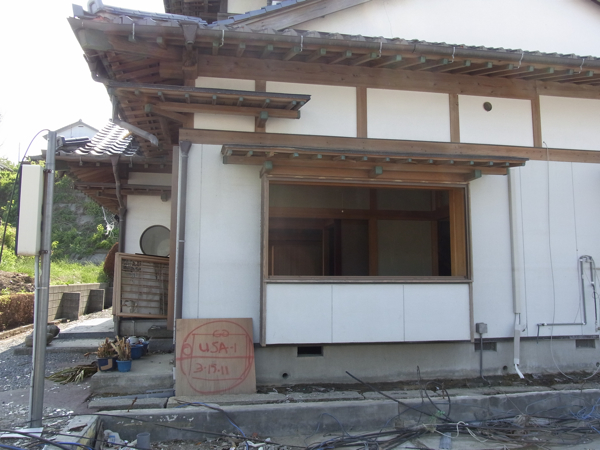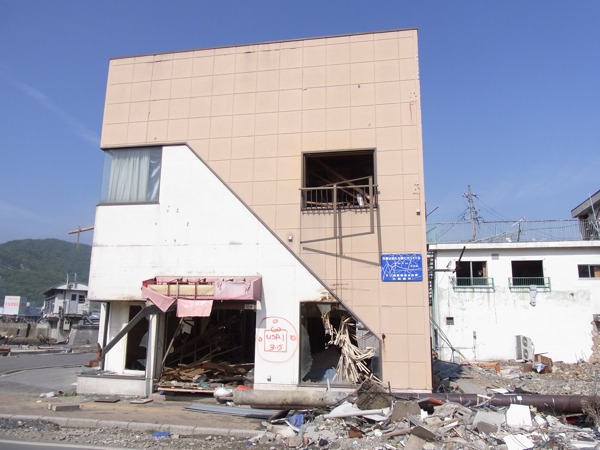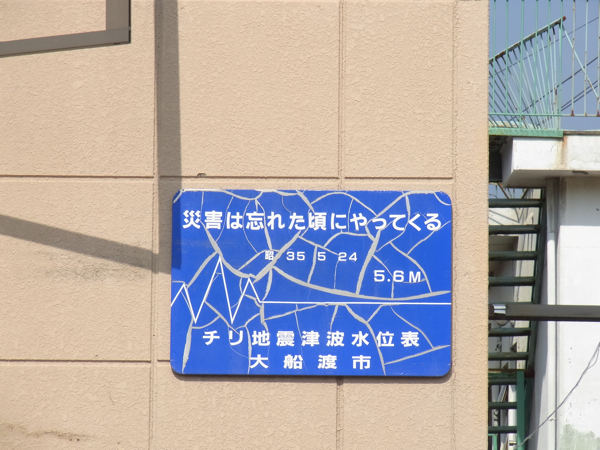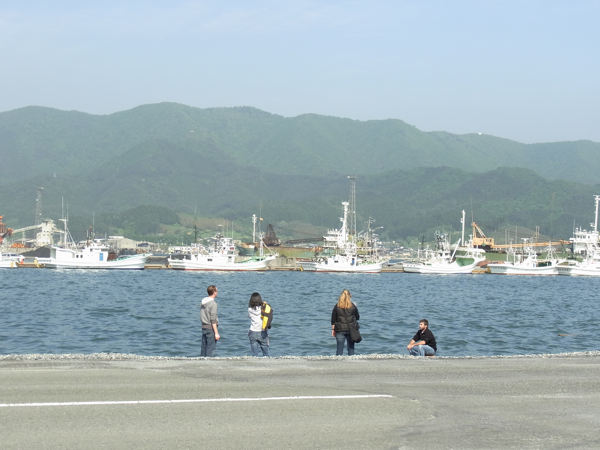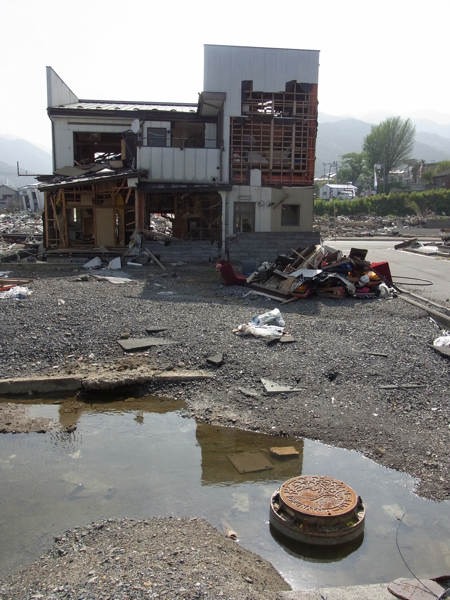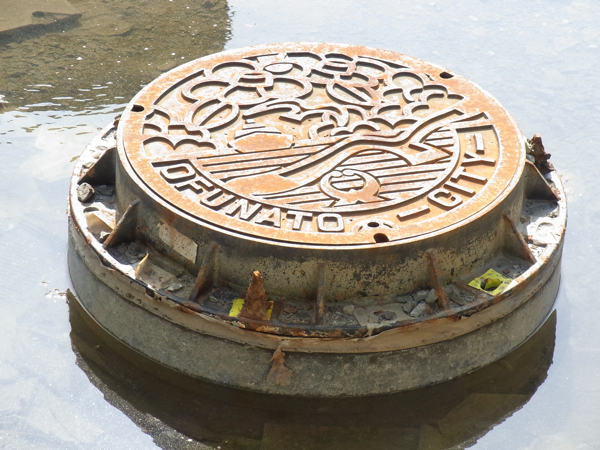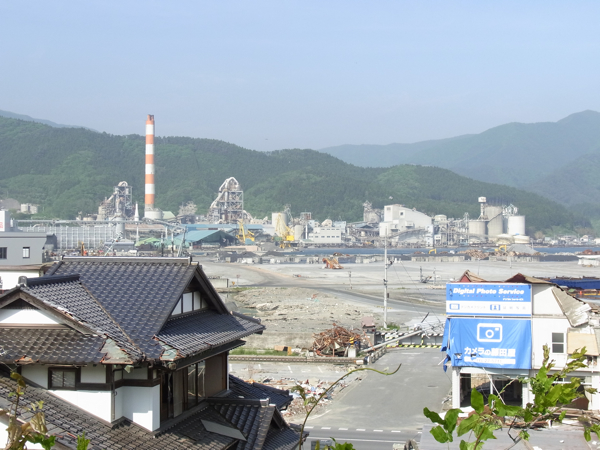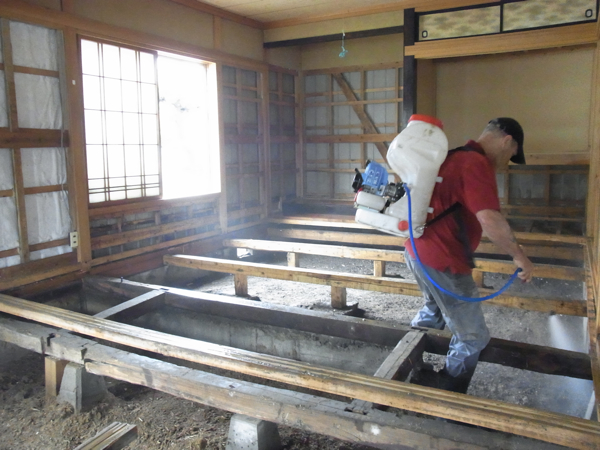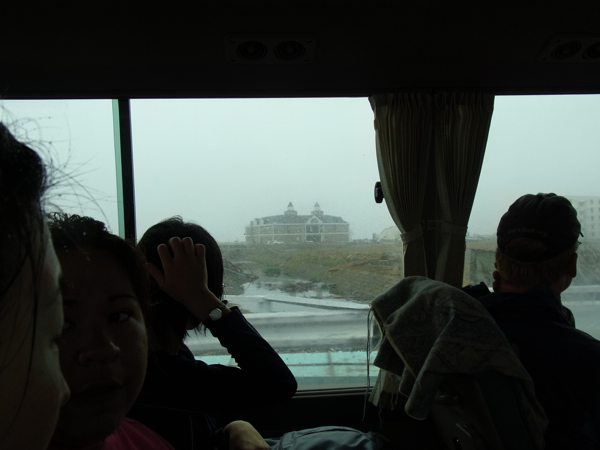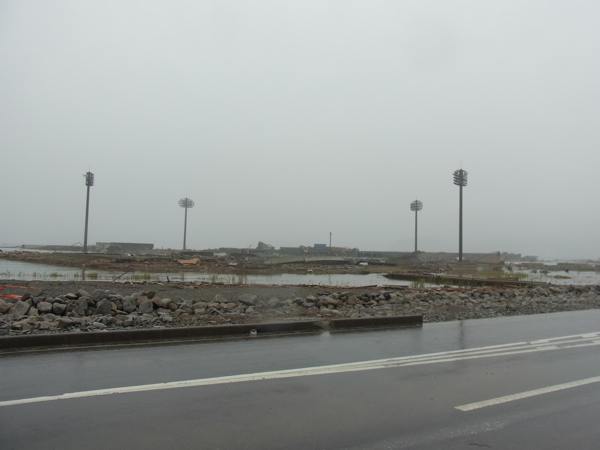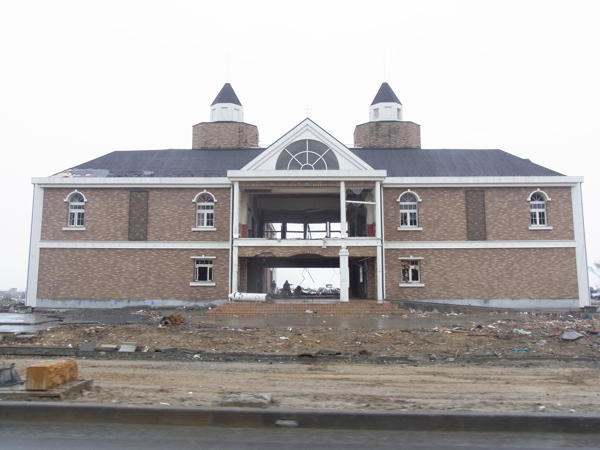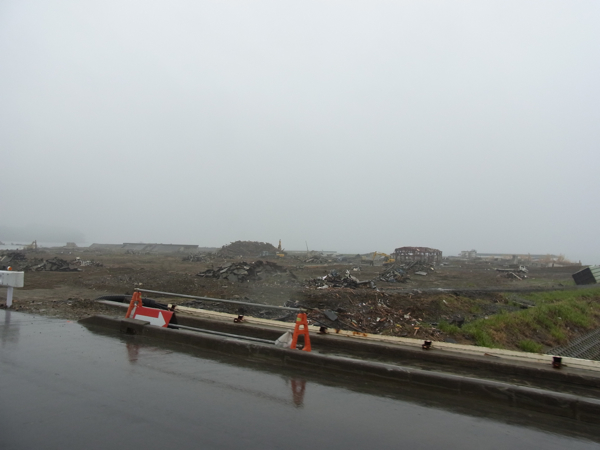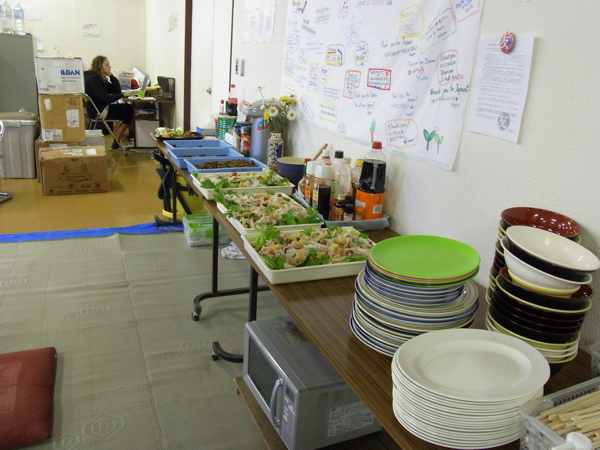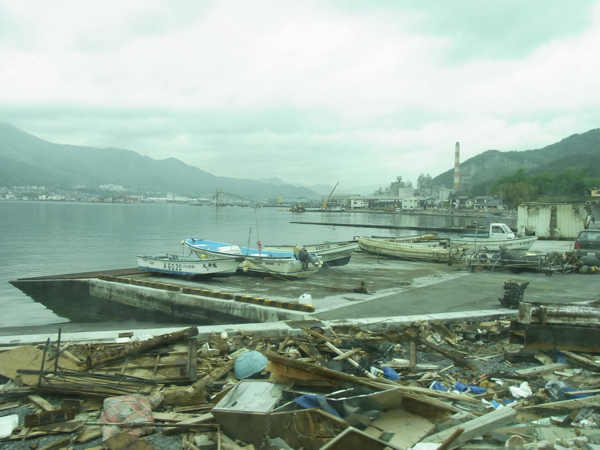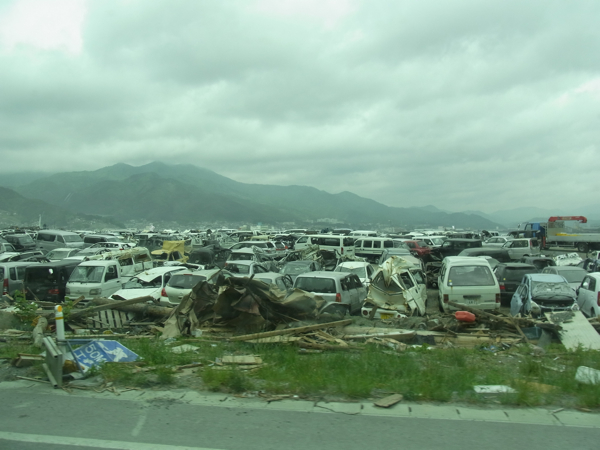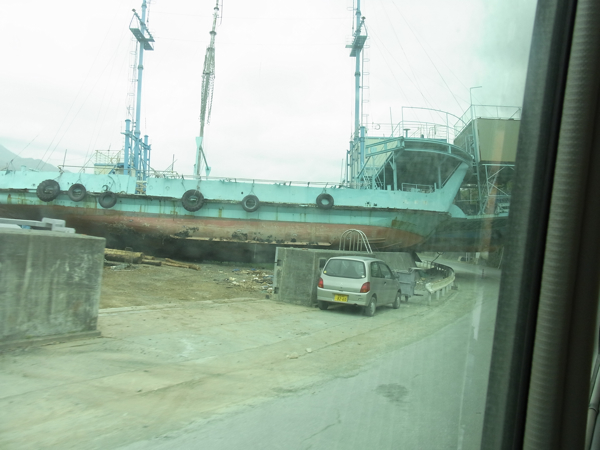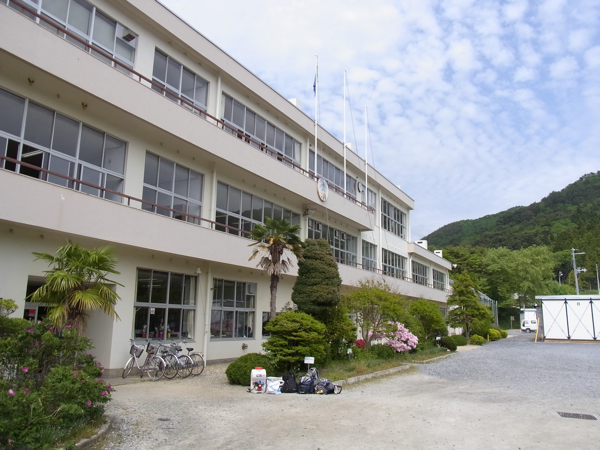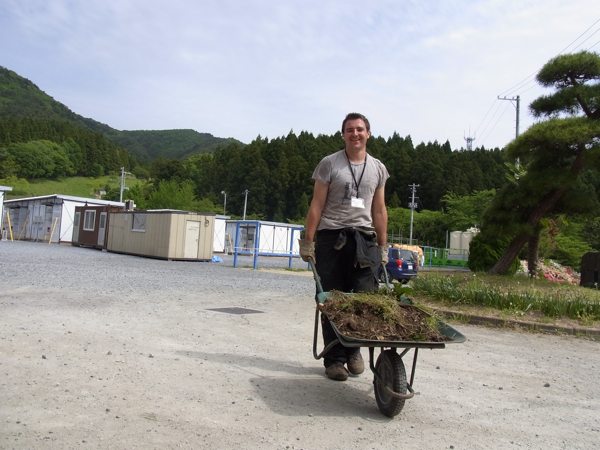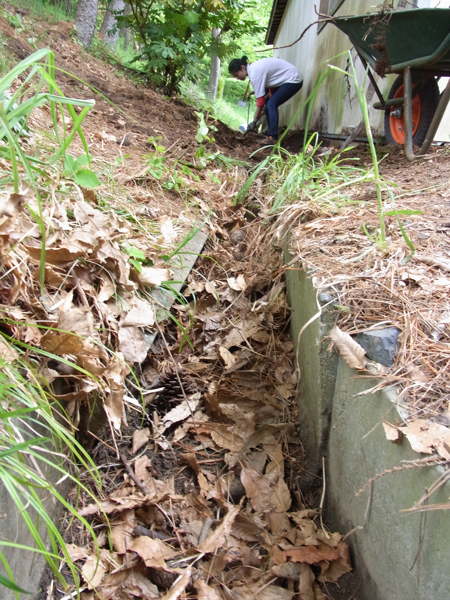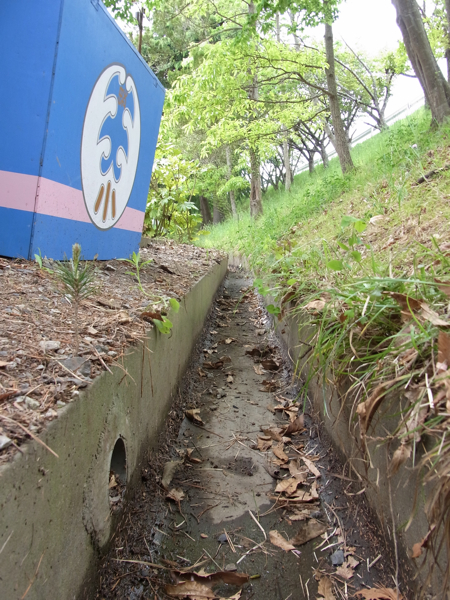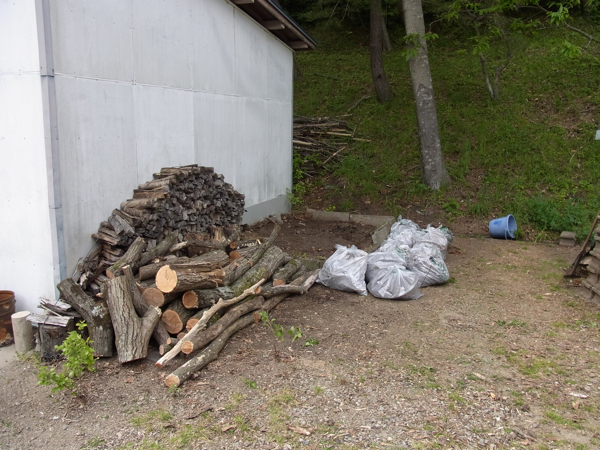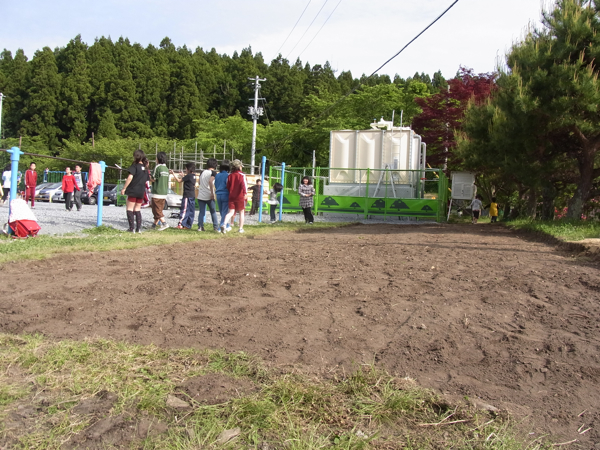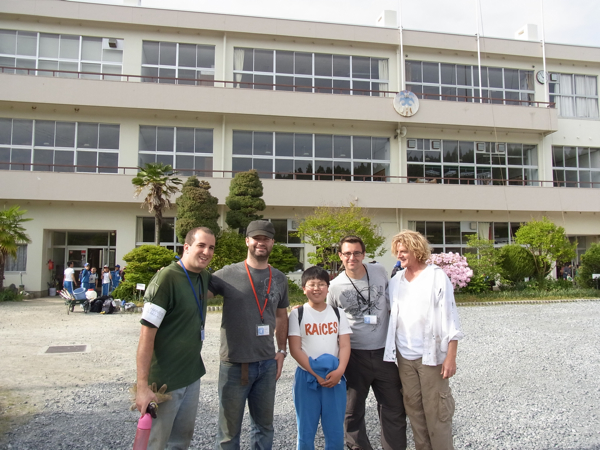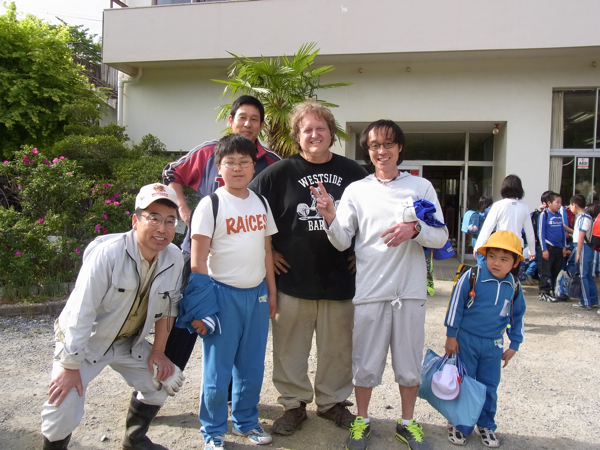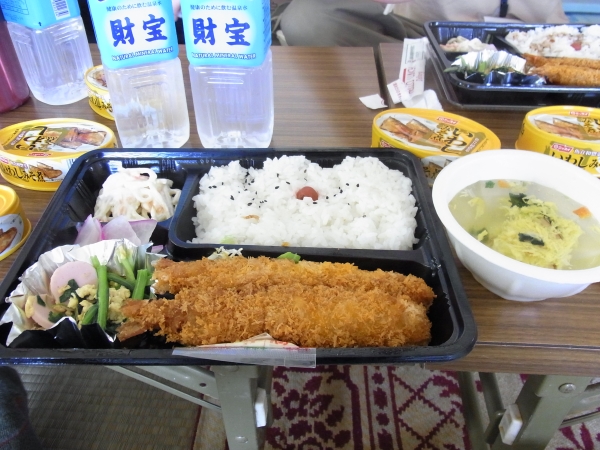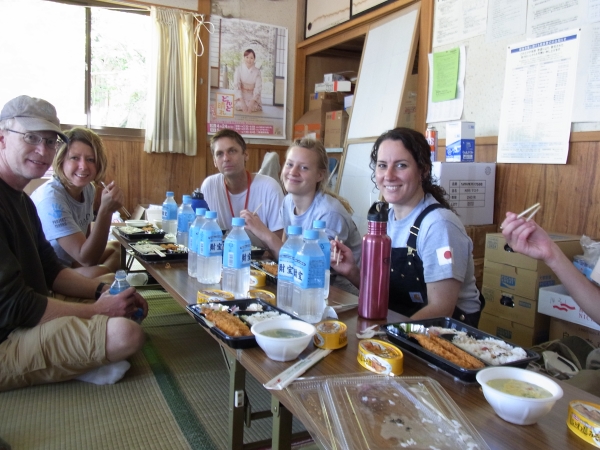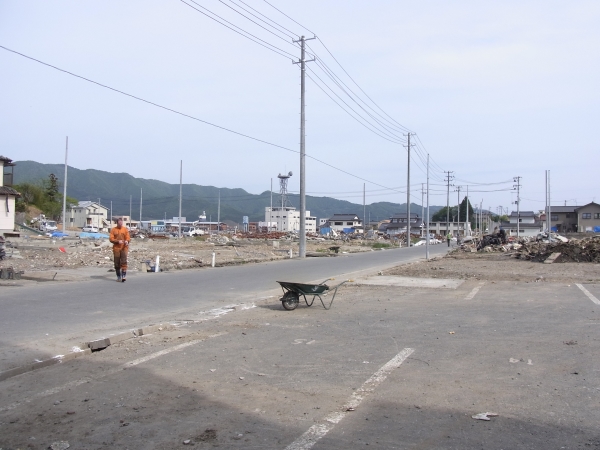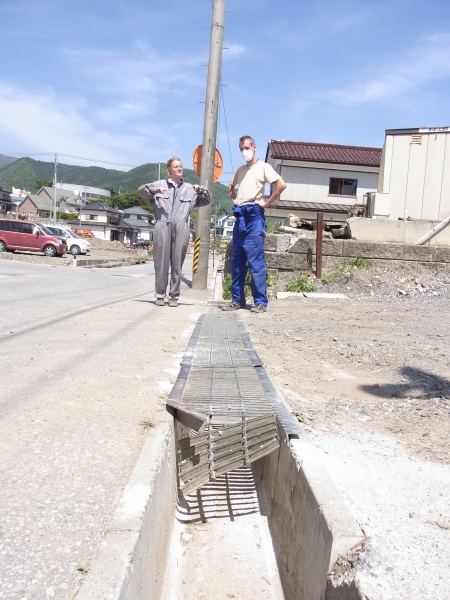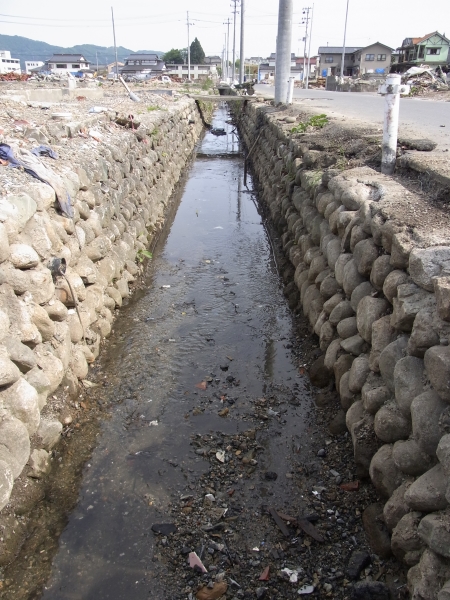Former Google employee and All Hands Volunteer Ryo Chijiiwa gave a talk at Google Japan before he flew home late last week. He starts out with a quick introduction to his path to volunteering (which includes a very interesting look at the hut he built in northern California) and then moves on to some of the activities that All Hands has been doing in Ofunato on Project Tohoku. Highly recommended viewing.
Tag Archives: project tohoku
Day 10 with Project Tohoku in Ofunato
Last day in Ofunato. I went with Keith and two other guys to take up the floor on a small house and disinfect the soil underneath with EM spray. The house was interesting. It was a small wooden house with only two rooms – a bedroom and a storage room. Very old. So old that the boards of the house had dried up and brittled into a gray color. At first I thought it was connected to a newer structure whose occupants were giving us instructions, but actually it was an entirely separate building. The resident was gone for the day. The newer building was just built in a way that wrapped around the older building. The gap between the two couldn’t have been more than six inches.
We removed everything from the bedroom and took up two boards to get a look under the floor. Because the boards were so old, we decided to rake the mud from outside of the house rather than risk breaking any of the floor. Underneath the house was a treasure chest of old wood and bamboo, possibly from when the house was first built fifty or sixty years ago. Once we dragged all of the stuff out, we raked a bit of the mud, sprayed the EM disinfectant, and then moved on to the newer structure which had actually taken more water during the tsunami. The front room of the building had about a foot or so of water, so we removed the boards from part of the front room and sprayed underneath a hallway. We also had to go back and spray a small additional bit of the older house.
We managed all that in the morning, so in the afternoon we joined up with the team working the ditches. The ditch team was an appropriate way to end my time with All Hands – that’s what I did my first day. The team has made significant progress since that day. They are within a block or two of the local NTT building – much closer than when I first got here.
Keith and Norm, an older Scottish/Engishlman, were racing through some of the ditches, and we really made a lot of progress in the short time we were there. Supposedly our ditch digging and canal cleaning have made quite an impression on the local authorities. They’ve asked All Hands to do 4km more of the ditches – 2km on either side of a road.
I gave a short farewell at the evening meeting, and we hung around the Sakari Base drinking beers for a little while before walking back to the Fukushi no Sato Center.
Although I’m leaving tomorrow (after I spend the morning doing housekeeping at the Fukushi no Sato Center), Project Tohoku will be in Ofunato for a while. All Hands just announced an extension from July until September. Knowing that the Haiti project is still going strong, who knows how long Project Tohoku will continue if funding isn’t an issue. So definitely send in your information to the project to keep up with the latest information, and donate if you have the cash. As far as I know, they are prioritizing Japanese and Japan-residing foreigner volunteers over international volunteers, but if you can speak Japanese and English somewhat fluently, you can help do important interpretation and they’ll probably consider your application. Japan has given me so much over the past ten years, and I was really glad to give back, even if it was just for ten days. Maybe I’ll find a way to come back and help out again. Hopefully some of the people I’ve met here will still be around then.
Day 9 with Project Tohoku in Ofunato
Today we finally finished at the Ueno’s house. Three of us mudded the last couple of sections of the house, including the section that had previously been filled with water, and Keith took out the old septic tanks with a sledgehammer. The Uenos added a section onto the original building, and when they did, they put in a new toilet and left the old concrete septic tanks empty under the house. In the tsunami they filled with water and mud, and rather than digging out the mud, it was easier to break them up with a sledgehammer and dig out the rubble. Keith also sledged out the concrete from the in-floor kotatsu.
We were close to finishing at noon, but we would have left the place a bit of a mess, so we ended up staying all day. In the afternoon we took our time ensuring that all the nails in the frame of the house had been pounded flat and cleaning up after ourselves.
The couple came back later in the afternoon as did the carpenter who is working with them. There was a brief moment where I thought we had messed up big time. The husband gave us permission to destroy the old septic tanks earlier in the day, but the carpenter had a look of concern on his face when he saw the work. He started talking quickly with the wife and then asked me a few questions with words I couldn’t understand. The wife went to ask the husband something, and I turned to Shinpei to ask about the words and the process that the carpenter had described. Apparently in Japan when a family stops using a toilet, they have a priest purify it ritually with salt, an ofuda (shinto talismans often hung at shrines), and a blessing. This prevents any misfortune apparently. The toilet had been put out of use long before, so it was probably fine, and the couple didn’t seem too concerned.
One interesting note today was that there were more workers on the debris pile. It had been mostly flattened by the crew yesterday with the mini-crane and trucks, but there were three guys today on their hands and knees sorting through the soil, separating pieces of trash from dirt. It was dirty, thankless work – unbelievable to watch. By the end of the day they had finished approximately a third of the trash area.
A dozen of the volunteers have headed off to a satellite project in a town called Yamada, so I said some goodbyes today. There are fewer Japanese/English bilinguals around, and they’ve been sorting us into jobs before the evening meetings. Tomorrow is my last full day on Project Tohoku, and I’ll be at another gutting/mudding site with Keith. It’s just one room that needs the floors torn up and replaced within a day. Should be a fun last day.
Updates – pictures:
Two shots of the neighborhood near the Ueno’s house and store. In the first, the roof on the warehouse to the right is ripped back – this happened during the recent typhoon, not during the tsunami:
The Ueno’s store. Both entrances are temporary and were added after the tsunami:
Keith and Craig talking on the right, and on the left the Japanese workers sorting through the trash pile slowly but surely, making their way toward the store:
The temporary door for the house that I helped Vince build:
Group photo – L-R: Shinpei, Craig, Keith, the carpenter, and then Mr. and Mrs. Ueno on the first row:
The carpenter showing us his 40-year-old tools. Impressive.
Day 8 with Project Tohoku in Ofunato
Today I was back at the Ueno’s house with Keith and Vince finishing up the gutting job. Mr. Ueno was there when we arrived, but he left quickly after. We found a tray of breakfast cakes and onigiri rice balls to eat during our break along with a box of drinks. They are a really sweet, generous couple.
There were only four of us today, and we slightly underestimated the time it would take us to finish the job. We expected to finish by 1pm, but we took all day and will go back tomorrow for a few hours. Keith and Vince spent the morning demolishing the bath area, which was difficult since the walls were lined with steel and then covered with concrete inlaid with tile.
Shinpei, a Japanese guy from Ibaraki, and I worked on taking out the subflooring in one room and then “mudding” another room. Mudding is basically shoveling the top two inches of soil that has accumulated under the house. It makes the rooms look neat, and it also removes the last of any debris that washed up underneath the house during the tsunami.
While we were mudding, we also helped Keith and Vince remove their trail of destruction. They were throwing sheets of metal, blocks of concrete from the bathroom floors and walls, and flooring from the last of the floor that we had to take up. We basically needed one more person with us during the day to run the wheelbarrow back and forth and we probably would have finished in time.
One new part of today was the construction workers outside of the house. There was a huge pile of debris immediately next to the Ueno’s house. It was a pile for the whole neighborhood, and we had been dumping on it over the past few days, but today there was a construction crew that was using a mini-crane to lift the debris onto trucks which took it away to a different location. The guy running the crane came up to talk with me at several points, helping us direct our trash to the right location. He and his team made pretty quick work of the pile – it was gone by the end of the day. He was also a little curious about us volunteers; he had a curious smile on his face the whole day, and we had a short conversation as he was heading off after finishing.
Part of the reason we were able to have this conversation was because our bus was late. This also enabled us to talk with Mrs. Ueno who came briefly around lunch and then returned later in the afternoon with her older sister-in-law. We all talked, and I translated for Keith and Vince. Neighbors who walked or biked by stopped to say thank you. The sister-in-law also gave us a big bag of canned coffee and eighteen tai-yaki (fish-shaped, red-bean filled Japanese cakes) to share with everyone. It felt kind of like a goodbye, and it probably should have been, but we’ll be back tomorrow to put the finishing touches on the job. Then we’ll head back to the canals for more shoveling.
Updates – pictures:
Vince and Keith demolishing the bathroom walls – steel-lined concrete:
The gutted house with just a path through the middle remaining:
From L-R: Vince, Keith, sister-in-law of the owners, her son Take-chan, Mrs. Ueno, myself.
Day 7 with Project Tohoku in Ofunato
Tuesday is the weekly day off at Project Tohoku. This is to enable local volunteers to join the group on their weekends off. I wish I could say I slept in, but I actually woke up at 4am sharp. I was back to sleep at 5 after watching a little TV.
I did laundry and relaxed around the base in the morning, and in the afternoon a bunch of us went for lunch at a local restaurant and then took a walk down to the water. The bus that picks us up had driven by the area before, but it was different on foot – starker and more barren. There was a building with a sign marking the height of the water from the 1960 Chile earthquake tsunami at 5.6 meters. It also read: 災害は忘れたころにやってくる – disaster strikes when it’s been forgotten.
Right around the point where we felt we had walked a good ways and were about to turn back, we took a left and were able to access the water. We could see the concrete plant across the bay, ships docked, warehouses along the bay that had been mangled, and the huge swath of empty land beyond the immediate coast that the tsunami destroyed.
On our way back we walked on a road parallel to the one we walked down on, and we walked up a small hill that had been designated as an evacuation area. It was one block from the main road along the bay, so only three or so blocks off the water, but everything on the top of the hill was fine.
After that we walked home, stopping by a grocery store on the way. In total we walked something close to 10K, maybe even more, so I was too tired to join a group driving to a hot springs and going out for dinner. I walked over to a place called the Ys Center, which is right next door to the Fukushi no Sato Center. It seems to be a community/sports center. There’s a heated pool and a bath, and we can use the bath. After a scrub and some dinner, I’m ready for bed but need to kill two hours first. Back to work tomorrow.
Updates – pictures:
Pictures from the walk. They don’t really capture the scale of the destruction:
This building had the sign commemorating the 1960 tsunami:
Day 6 with Project Tohoku in Ofunato
A full week finished! We have the day off tomorrow, and it couldn’t have come sooner. Today was a cold, blustery day.
I was with a team lead by a British-born US-based sixty year old named Keith. He looks like a combination between Keith Richards and Christopher Lloyd (from his role as Doc in Back to the Future). He’s a no-nonsense team leader, and he was all over the place instructing the team on how to remove water-logged drywall, remove floorboards, take out the subflooring, and all the other tasks we had to complete to gut the building.
The building we were working on used to be a clothing store owned by a family named Ueno. They live in a big, spacious house across the street from the store, and both of the buildings are within view of the coast. They took standing water up to six inches below the first floor ceiling, so almost all of the wood in the building has rotted.
We had a really productive team, and we got a lot done. The mother of the family was there helping take care of smaller things as well as serving us hot coffee during break time and providing us with a range of tasty Japanese snacks. Yesterday the whole family was there, and even the three year old was sweeping up.
Midway through the morning, Vince, one of the co-leaders, and I went across the street to help fix up the front door of the family’s house. This was not one of our tasks, but the family has been so nice that the team wanted to do it, and one of All Hands’ mottos seems to be give a little extra – a little lagniappe, I guess.
The door is a wide Japanese-style sliding entrance that had been totally destroyed. It faced the water, and the wind off the bay was strong and rainy – the remains of a typhoon that dissipated over the Tokyo area into a rainstorm last night. The family had tacked up a blue tarp, but it was flapping into the house and slowly being pulled out from above the door. The entranceway was getting wet, as was the house, which had recently been drywalled. Vince and Keith designed a frame that we could press into the doorway and support from behind with long sticks of wood. I was a nonbeliever at first and was thorougly impressed when they banged it securely into place between the existing entrance, leaving only a space as large as a single doorway open to the elements – much smaller than before.
My job was to help Vince pull nails, straighten the nails so we could use them again, and hold pieces of wood together when he nailed them. It was cold, wet work, as the house was more open and wetter than the store. I was ready for the coffee at lunch time.
After lunch we finished the door and then rejoined the rest of the gutting team. We managed to remove almost all of the subflooring except in an area that had filled up with water due to a culvert that broke during the earthquake. It filled up from the rainwater and should lower by Wednesday so that we can continue the work.
It sounds like the team will be returning on Wednesday after our day off. We still have to remove all the mud that accumulated beneath the subfloor, remove some of the subfloor that remains, and then spray the whole area with material to prevent mold from growing. I’m not sure if I’ll be going back to the house or not. I really want to, but a team may be returning to the school I visited last week, and it would be nice to do that again too. It may also be time for me to return to manual labor. We’ll have to see how things go.
There has been one change in process from Wednesday on. Japanese speakers will meet five minutes before the meeting and divvy up onto the project teams to ensure that there will be Japanese speakers on site. This gives us some freedom to choose before others, but I’m not sure if they’ll be letting us double up or not. It will be interesting to see. I was a little hesitant about my Japanese going into the volunteer experience, but I’ve had a couple of good interpretation experiences. The first was on the canal day when I spoke with local construction authorities to set up an alternate dump site. The second was the school principal. And the last was today when I intepreted between Keith and the family’s carpenter who has been assessing all the work we’ve done on the building. I haven’t had too much trouble at all, which is reassuring.
Day 5 with Project Tohoku in Ofunato
This morning I cleaned up the Fukushi no Sato Center with three other people. We swept the floors, vaccuumed the carpets in our common living spaces, cleaned the bathrooms and the toilets, and cleaned the bathing/shower areas outside of the big tub. There are some days when the tub itself is scheduled for a clean, but today was not one of those days. I made friends with some of the staff because I was constantly asking them for refills of cleaning liquid, extra toilet paper, and foot mats to put down in the bath.
I also got a peek at the daily activities of the residents. On the first floor there are eight or so rooms that house old people that need help living. This morning they were up and about, and people were helping them out. They get bath time at around 11am, so we had to finish the baths by then.
This was not the most glorious of work to be done, but it has to be done, or else the areas where we live would get filthy. I was comfortable with all of the work we did today because of the time I’d spent on Dorm Crew – a student run program at my college that hired students to clean dorm toilets during term time. During the summer we did a full clean of all the dorms. Signing up to clean Fukushi no Sato Center also meant that I got first choice of jobs for tomorrow.
After we finished, we walked down from the Center to Sakari Base to have lunch and join up with other teams for the afternoon. The first team I was joined was basically done for they day. They were gutting two houses – all the floorboards were torn out, and the drywall had been removed. After that, the team sprayed a substance which is called EM. I need to research this substance a little more, but apparently it comes from Okinawa and is some organic compound made of yeast. It can be recreated effectively several times using sugar, and the yeast or whatever is in it eats away all the germs. So I watched as another guy sprayed the house. I helped do a little detail work on left over drywall.
After we finished there, I joined with another team which is organizing a new base across from the Sakari Base. Someone connected with All Hands owns the building which used to be a music store. The store closed long, long ago and has since been used as storage. It’s filled with all different types of furniture, pieces of wood and metal, boxes of CDs and posters, huge stacks of plates of glass, and more. Everything was covered with dust. For the last hour or so of the day, I helped move things from the second floor to the first and separate them into useful and non-useful piles. The building is a cool space, and once they get it set up, it will really make life around Sakari better for volunteers – they plan on installing showers, so they won’t have to use random showers anymore.
Tomorrow I’ll be working wit a team removing floorboards and gutting a house. It should be interesting to see the project from start to finish. Today I was only able to see the house after the floors had already been ripped out.
Oh, and we went out for karaoke tonight because it was one of the team’s last night. I managed to get everyone into cabs and back to the Center before the 10pm curfew. Great success.
Updates – pics:
Here is Norm in action, spraying the EM disinfectant throughout a completely gutted house:
On the walk back to base from the house, I spotted the waterline on one of the houses. In the distance you can see the post office (with the orange sign) with a matching waterline. To give you an idea, this section of town is pretty far from the coast. It’s on the one of the main shopping stretches of Ofunato, which is parallel to the main highway a block over (like many Japanese towns):
Day 4 with Project Tohoku in Ofunato
Today I was with a group that headed to Rikuzentakada, a city about an hour away from Ofunato by bus. The group has been working on cleaning rice fields of debris and digging out ditches along the rice fields.
The city itself sustained far more damage than Ofunato. Unlike Ofunato, Rikuzentakada seems to have a more gentle slope from the coast up to the mountains. The tsunami pushed everything off the coast up into the rice fields that slowly rise into the mountains.
The bus dropped us off at the rice fields and we could see the coast in the distance. Four lights from a baseball stadium stood out against the water. One of the All Hands staff members said that the stadium had just been finished, and now all that remains are the lights and the concrete parts of the building. That was all we could see.
Most of our team moved into the rice fields to start picking out debris. Two members and myself worked on digging out the last of a ditch that they began yesterday. As with the other ditches, we had to pry off the concrete lids, dig the soil out, and then put the lids back. The contents were sandier than the area in Ofunato, and there was less debris. The work went relatively quickly, and we finished up in time for lunch. The group working in the rice field ran into an area covered with oil and raw sewage, so they had to abort their final field before lunch. There are some areas that need a lot of attention, and All Hands is not equipped to handle everything unfortunately.
After lunch, we moved to a different area of the city with safer fields, and the bus drove us closer to the coast, giving us a full picture of the damage. All the buildings along the coast are gone except for one western building, which is a museum. Even it took massive damage. There was a giant hole through the middle.
While the rice fields were in bad shape, it looked like they had already had some work done. There were big treadmarks on the soil, and all the immense pieces of metal had been stacked in different areas. There was still tons of debris, and we collected as much as we could into piles of wood, metal, and other. After work, the team leader commented that she just had to turn off while working, otherwise she just focuses on every item that she sees…there are so many personal items spread out over the field.
The lesson of the day is always check the free box. Because this is communal living and because there are constantly people leaving and joining Project Tohoku, the common areas have a healthy set of free boxes – boxes of food, clothing, hygienic supplies, etc. Last night, really just for fun, I tried on a pair of neon yellow plastic overpants. They were a little too small, but I remembered them this morning when I noticed it was drizzling outside. I threw them in my bag at the last second and was lucky to have them. It rained or drizzled most of the day, and the overpants kept my jeans relatively wet and dirt-free. So thank you, whoever left this pair of pants behind. They really came in handy. I’m going back tonight to secure the matching overjacket.
(I think I’ll post pictures when I get back to Tokyo. I’m exhausted most of the days when I return, and resizing pics on my netbook isn’t as easy as on my other laptop. I haven’t taken too many photos either because I’ve spent most of the time working, but I will post them retroactively later.)
Updates – pictures:
The coastline through the bus:
The photos from Rikuzentakada don’t accurately capture how complete the destruction is there. The whole coastline was wiped out.
Here are some pictures from inside of Sakari Base, including the job board, dinner, and the common area:
Day 3 with Project Tohoku in Ofunato
Well, I didn’t really get a chance to play with the kids today, but we did get a lot of work done, and there were a lot of kids around, so it didn’t really feel as strenuous as some of the other days so far.
We hopped on the bus with a team headed to a fish warehouse right on the coast. The area was wrecked, but surprisingly there were still some buildings standing – this may sound like a running refrain…I guess I was surprised considering some of the footage I had seen, not all of which came from Ofunato, clearly. It isn’t a total wasteland like you might imagine. The fish team had to remove a lot of rotten seaweed that had been sitting in cardboard boxes for two months. They stank so much on return that they went straight into the shower and their clothes into the wash (which apparently wasn’t that effective).
We continued on along the coast, past an immense factory (to make concrete apparently) with lots of tubes and hugely tall structures connected (like something out of FFVII), past two boats which had washed up onto the shore and stuck out onto the road, and then eventually up a hill to the school…which was untouched by the tsunami other than the temporary housing that had been installed in the school yard and some of the athletic fields. Part of this job was doing some maintenance work for the school, and the other part was PR and connection building – this was the first project that went into schools in the area, and it sounds like All Hands is looking forward to doing more work in the future.
We had two groups. The first removed cinder blocks from a garden in front of the school which we were later going to use behind a shed in back of the school. The second group, my group, was cleaning out a ditch behind the shed, organizing a big pile of wood that had been rotting behind the shed, and then stacking the cinder blocks on top of the drainage ditch. The area around the shed hadn’t been cleaned for thirty years.
The first group did wonderful. They totally cleared the cinder blocks and then took off the first few inches of topsoil to create a nice, soft area of earth for the kids to play on. At the end of the day it was great to see many of them running around on it, especially since a lot of their normal play area is occupied by housing.
The second group did good, but we weren’t able to totally finish. We moved all of the wood, threw out the rotten wood, restacked the wood neatly after clearing the area, removed all the leaves and brush from about 90% of the drainage ditch, and dumped all of the brush on a compost pile. One of the drainage ditches had partially collapsed, so we began to dig it out to stand it upright, but we didn’t have enough time unfortunately. Hopefully we’ll have the chance to go back and finish and do some other odd jobs.
The kids came out and talked with us on their recess. They were very curious, and the teachers were all thankful, especially the teacher whose tire our team leader Chris changed for him – the teacher got a flat on the way to work and had been unable to remove the tire.
One part of our team went to play with the kids after lunch, and several of the others joined in at around 3pm. At one point we helped other teachers in the school building move boxes from the gymnasium to classrooms.
I had the most fun talking with the principal of the school who was a loud, friendly guy – not your typical elementary school principal. In the schools where I taught, the principals were always nice but often secluded in their often. The one impression I have of them is that they always ate lunch really early. I always thought it was strange and possibly even rude until I learned it was a recognized procedure (apparently)…something about having someone available while others are eating or maybe to test the food for poison?
Well this principal was outside all day with us, helping rake leaves, dig dirt, talking with the Japanese speakers. He was really happy to have us there, and I hope we have a chance to go back. At the end of the day he asked us if we drank beer, which is usually a sort of indirect invitation to go out for drinks, and as we all know, real business gets done over drinks in Japan; hopefully this means that All Hands will be in good shape for future school projects.
Pictures forthcoming…
Update – pictures:
Here’s Sakari Base from the outside:
And some shots along the coast from the drive to the school:
Here’s the school we visited. You can see some of the temporary housing in the lower corner of the photo:
Paul with a load of soil from the work on the lawn in front of the school:
Ditches filled with leaves and then the finished product:
Neat and tidy pile of wood on the side of the toolshed, our pile of cinder blocks from the front garden and in the distance the compost heap where we dumped the leaves:
A nice, smooth patch of soil for the kids to play on:
Team leader Chris with the principal (on the far left) and the lucky teacher whose tire Chris changed (right of Chris):
Day 2 with Project Tohoku in Ofunato
I was with the same ditch project, but today I was working on the canals instead. I started off taking buckets from the diggers and wheeling them to the dump site, but in the afternoon I jumped in the canal and helped shovel. For the last hour or so I was working on a different section of the canal that we haven’t reached yet. I fished out the biggest pieces of debris like roof tiles and other things and put them on the side of the road to be carted away.
Everything else other than that was the same as yesterday. We have a different team of people, so things ran a little differently, but it was all tough labor out in the sun.
Here is some of our group eating our delicious bento lunches. We ate at this small house near the work site, and the lady there made us soup yesterday and today. Yesterday she also boiled us eggs, and today she gave us cans of miso sardines. Very tasty.
This is the area of town where we were working. As I mentioned yesterday, the destruction was very spotty. Some things are totally gone; others are still standing. This photo is facing the coast, so you can see that some things closer to the coast are still standing.
Here’s a photo of a very clean ditch. I’m not sure if our team worked on this, but this is what they look like when we finish with them.
And here is the canal I was working on. This is what it looks like when it’s dirty (although we had done one pass…the section I worked on at the end was much, much dirtier).
And here’s a clean section.
A group of Japanese officials came by and took photos of us working. I gave them my email, so hopefully they’ll send them my way soon. I’ll post them up when I get them.
After two days on the ditches and canals, I’m ready for a new assignment. There’s a project going to do some work on a the grounds of a school, and I’ll be joining them. In the afternoon we should have a chance to play with the kids. I’m very excited to be back teaching again, even if it is just for an afternoon.

